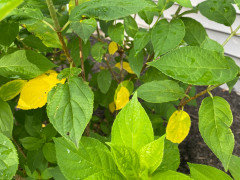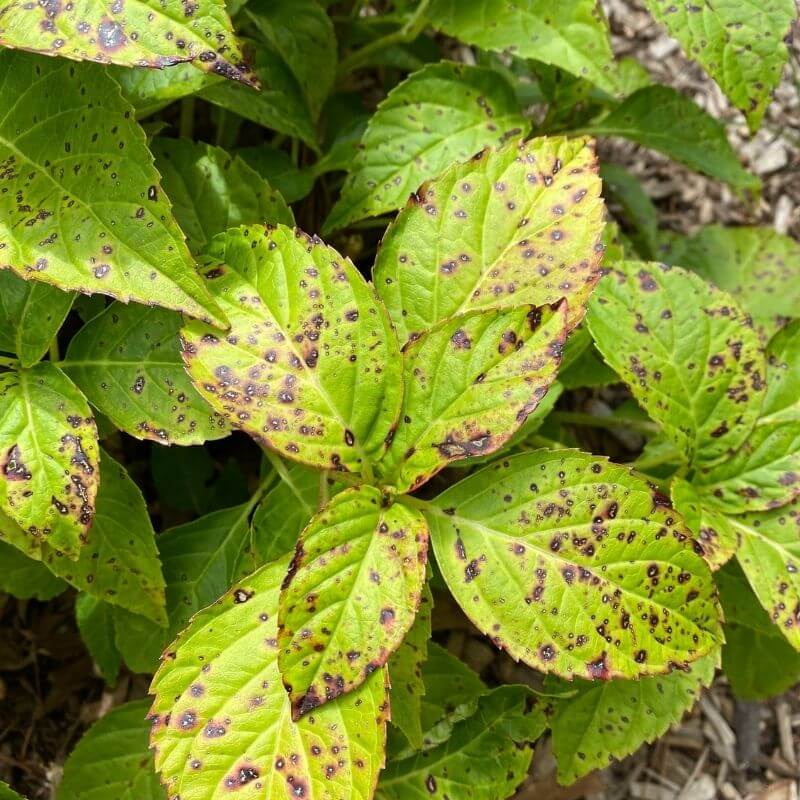The Greatest Guide To Hydrangea Leaves Turning Yellow
Wiki Article
The Single Strategy To Use For Hydrangea Leaves Turning Yellow
Table of ContentsThe Ultimate Guide To Hydrangea Leaves Turning Yellow5 Easy Facts About Hydrangea Leaves Turning Yellow Explained10 Easy Facts About Hydrangea Leaves Turning Yellow ShownIndicators on Hydrangea Leaves Turning Yellow You Need To KnowGetting The Hydrangea Leaves Turning Yellow To WorkEverything about Hydrangea Leaves Turning Yellow5 Simple Techniques For Hydrangea Leaves Turning YellowThe smart Trick of Hydrangea Leaves Turning Yellow That Nobody is Discussing
You can try to stop fungal diseases by keeping your gardens cool and devoid of particles. Provide your gardens a good loss and springtime clean up (Hydrangea Leaves Turning Yellow) and remove all leaf clutter from the ground, along with from within the crown of the plant. These leaves that will stick around, waiting to assault in the next expanding period.Copper fungicides are, but if they are overused they can end up being toxic to your plant. Clip the fallen leaves, and remove them from the yard.
If they aren't getting adequate water, their leaves will brownish. Hydrangeas have a in the midday sun, and recuperating as soon as the sun has moved and the plants have a long time to recover. If this happens repeatedly you might notice brown and crunchy fallen leaves that are drooping. This is their method of allowing us understand that it requires some added moisture.
7 Easy Facts About Hydrangea Leaves Turning Yellow Explained
!! Water them slowly so the plants can saturate up that water. Generally in locations where plants have actually ended up being dried out, the soil is dry and the runoff of water becomes a problem.Established plants may require to be sprinkled one to 3 times per week, depending on your conditions. It might seem appealing to spray the leaves down.
Water the base of the plant,. Once the plant has actually recoiled, you can resume a regular watering timetable. A lot of types and varieties prefer partial sunlight. Panicle hydrangeas love complete sunlight, but the remainder of the group really suches as partial shade. Partial color supplies about 4 to six hours of sunshine.
5 Simple Techniques For Hydrangea Leaves Turning Yellow
The container needs to be big enough so the plant can grow and get all of the water and nutrients it requires. Panicles love the full sunlight.Regardless of the selection, strategy in advance and make certain your plant has lots of defense from the wind. You could transplant to a brand-new location, or you could create a wind obstacle making use of an additional plant, or secure fencing.
Ornamental grass, Rose of Sharon, or Holly shrubs are simply a few ideas of plants you could utilize to block the wind. If you need to transplant, find a spot in your garden that is well safeguarded from sun and wind. Transplanting is ideal done in the fall or the springtime.
Getting My Hydrangea Leaves Turning Yellow To Work
The plants area is the most crucial factor when it comes to obtaining well established and proper development. With a little forethought on growing location and correct maintenance, you'll be able to ensure your hydrangeas!.So, if Hydrangea leaves turn yellow and falls off later, it's generally as a result of overwatering, as the plant can not uptake water and drops the leaves to remove transpiration. Following this, Hydrangea leaves begin to droop and shrivel. Considering that both conditions can create yellow fallen leaves, you ought to spot the distinction between the overwatered click here for more and underwatered plant.
You can rescue the plant from yellow fallen leaves by using it the appropriate light and positioning. If your plant obtains yellow fallen leaves, relocate it to a dark location.
10 Easy Facts About Hydrangea Leaves Turning Yellow Described
, and temperature level changes can create yellowing fallen leaves and brown spots. If it gets also warm, the sides of the fallen leaves end up being yellow, turn brownish and create a crunchy appearance.
Heavy soil can quickly block the oxygen supply to the roots and sever the connection with the upper parts of the plant (leaves) (Hydrangea Leaves Turning Yellow). Hydrangea leaves change their color if they find minor aggravations in the dirt composition. This issue can cause the Hydrangea delegates turn yellow, experience fallen leave decreases, and render a droopy plant in sync with overwatering
However, yellow leaves in Hydrangeas are the first signs of disease infestation, typically complied with by black areas, browning, drops, and wilting. Separate the infected or pest-infested plant from the healthy plants to avoid illness spread. If it is a yard plant, eliminate all the contaminated fallen leaves utilizing sanitized devices and cleanse up all the particles.
Some Ideas on Hydrangea Leaves Turning Yellow You Need To Know
So, cutting off aids Hydrangea shade unnecessary weight and protection, permitting the growth of new leaves. The best time to trim Hydrangeas is spring when the plant is all set to sprout vegetation moved here for the next period. Examine for invested or diseased fallen leaves and cut the base of a stalk that signs up with the fallen leaves and stem.Avoid cutting healthy and balanced or green leaves, and do not eliminate even more than 25% of the plant's foliage. The main factor behind the red fallen leaves in Hydrangea is poor dirt or environmental problems.

Some Known Facts About Hydrangea Leaves Turning Yellow.
There are 6 primary reasons why this may happen:: The plant does not obtain enough sunlight.: The roots are either also wet or also dry.: The plant is too cold.: The dirt is not acidic or alkaline sufficient for the hydrangea.: The plant isn't getting the ideal nutrients it needs to remain healthy.Each factor impacts the plant in a way that can be dealt with if we understand how to care for hydrangeas the proper way. When we speak regarding insufficient light for hydrangeas, we indicate that the plant isn't obtaining enough sunlight. Hydrangeas favor bright light, but not straight, scorching sunlight. They typically thrive ideal with early morning sunlight and mid-day color.
Without adequate sunshine, the leaves can turn yellow, the plant can come to be weak, and content it might generate less flowers. To guarantee a hydrangea receives ample light, it must be put in a spot where it can enjoy the early morning light and be secured from the extreme mid-day sunlight. Overwatering is when a hydrangea plant gets more water than it needs.
The 10-Minute Rule for Hydrangea Leaves Turning Yellow
Yellow leaves might be a sign that the plant is getting too much water. On the various other hand, dehydration happens when the plant does not get enough water.This problem is common in the loss as the climate adjustments or if a hydrangea is planted in an area where it does not get enough heat from the sun. It is necessary to recognize the appropriate conditions for hydrangeas to stay clear of low-temperature anxiety. A lot of hydrangeas grow best in areas 6 to 9, where the environment is milder.
It's vital to know that this kind of yellowing is various from the yellowing triggered by problems like way too much water or otherwise adequate light. If the yellow leaves are mostly at the bottom of the plant and the remainder of the plant looks healthy and balanced, it might simply suggest that the fallen leaves are merely getting old.
Report this wiki page